Engines for use in Unmanned Aircraft
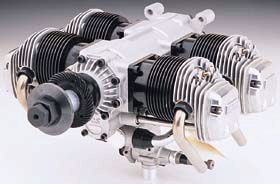
O.S. Engines FT-300 two cylinder engine from www.osengines.com
2 Stroke vs. 4 Stroke Engines
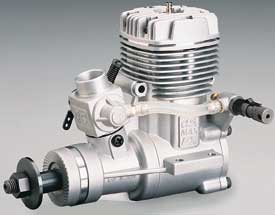
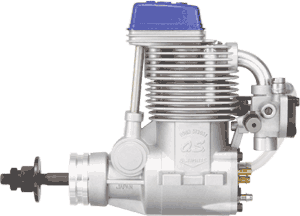
Example of a 2 stroke engine (left) and a 4 stroke engine (right).
| Parameter | 2 stroke | 4 stroke |
|---|---|---|
| power per cc engine capacity | 76 | 73 |
| power-to-weight ratio | 2.893 | 1.727 |
| engine efficiency J/ccfam | 0.654 | 0.813 |
| noise level | high | low |
| vibration level | high | intermediate |
Notes
- Most of the two stroke engines were petrol (gasoline) powered, whereas most of the 4 stroke engines were methanol powered.
- J/ccfam = energy in Joules per cc of fuel-air mixture
- For 2 stroke, J/ccfam = ( power_in_watts x 60 ) / (capacity_in_cc x rpm ) = measure of energy efficiency
- For 4 stroke, J/ccfam = ( power_in_watts x 60 x 2 ) / (capacity_in_cc x rpm ) = measure of energy efficiency
Engine induced vibration
In a microgravity geophysical survey, the range of gravity values is typically of the order of150 uGal. To perform such a survey requires use of a very low vibration engine in the UAV, unless one resorts to use of a towed sensor system. An in-flight two-stroke engine induced vibration level of 2.7 g rms = 2,647,795,500 uGal would completely swamp any sensitive microgravity measurements. The maximum allowable vibration level is 1,000 times the maximum gravity measurement value, in other words, 150,000 uGal, suggesting the need to use a very low vibration Wankel engine.
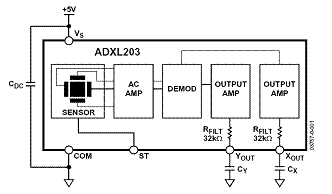
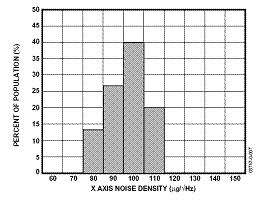
The minimum noise limited measurable acceleration, using 16 inexpensive MEMS-based Analog Devices ADXL203 accelerometer ICs operating in parallel, is 27,000 uGal / sqrt(Hz), based on data from www.analog.com. This measurement limit is suitable to detect unacceptable vibration levels in a UAV in excess of 150,000 uGal, for example.
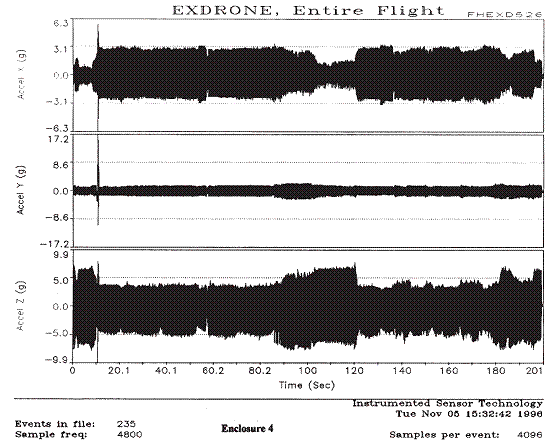
One can see the vibration levels for X, Y and Z directions, measured in an Exdrone Unmanned Aircraft containing a 2 stroke engine, during flight, from uav.wff.nasa.gov/exdrone.pdf (link no longer exsts).
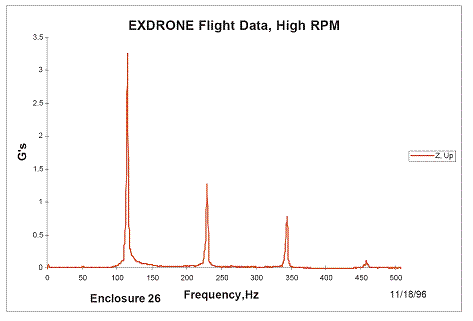
Vibration spectrum with a 3.3 g peak around 115 Hz (6,900 rpm) with higher harmonics. One can see the spectral representation of the above data for the Z direction, in which the vibration is largest. The 2.7 g root mean square vibration level in the Z axis for the Exdrone UAV, is way above the acceleration level we might wish to measure using a sensitive gravity meter and would completely swamp any microgravity measurements made, which would typically only change by up to 0.153x10^-6 g.
Links to manufacturers of small aircraft engines
Please remember that we do not endorse the following engine manufacturers. This information is simply provided to help you identify an engine that might be suitable for the task you have in mind. You will need to decide whether the engine actually is suitable.
- Advanced Micro Turbines
- Model Engine Corporation of America
- Modellmotoren
- O.S. Engines
- Rotating Cylinder Engines
- ROTO Engines
- Zenoah Engines